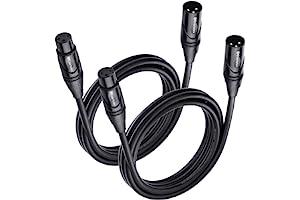Best Selling Microphone Cables
Microphone cables are used to connect microphones to audio equipment, such as mixers, amplifiers, and speakers. There are many different types of microphone cables available, each with its own set of features and benefits.
Links to Best Selling Microphone Cables
Types of Microphone Cables
The most common type of microphone cable is the XLR cable. XLR cables are typically used for professional audio applications, as they provide a reliable and high-quality connection. XLR cables have three conductors: a positive conductor, a negative conductor, and a ground conductor. The positive and negative conductors are typically made of copper, while the ground conductor is typically made of braided copper.
Another type of microphone cable is the TRS cable. TRS cables are typically used for consumer audio applications, such as connecting a microphone to a laptop or smartphone. TRS cables have three conductors: a tip conductor, a ring conductor, and a sleeve conductor. The tip conductor is typically made of copper, while the ring and sleeve conductors are typically made of tin-plated copper.
Finally, there are also RCA cables. RCA cables are typically used for connecting audio devices to televisions or home stereo systems. RCA cables have two conductors: a red conductor and a white conductor. The red conductor is typically made of copper, while the white conductor is typically made of tin-plated copper.
Choosing the Right Microphone Cable
When choosing a microphone cable, there are a few factors to consider.
- Length: The length of the cable will depend on the distance between the microphone and the audio equipment.
- Type: The type of cable will depend on the audio equipment you are using.
- Quality: The quality of the cable will affect the sound quality of the microphone.
If you are unsure about which microphone cable to choose, it is best to consult with a professional audio engineer.
Using Microphone Cables
To use a microphone cable, simply connect one end of the cable to the microphone and the other end to the audio equipment. Make sure that the connectors are properly aligned and that the cable is securely plugged in.
When using a microphone cable, it is important to avoid:
- Tugging on the cable: This can damage the cable and the microphone.
- Twisting the cable: This can also damage the cable and the microphone.
- Running the cable over sharp objects: This can damage the cable and the microphone.
By following these simple tips, you can help to extend the life of your microphone cables and ensure that they provide you with years of reliable service.

